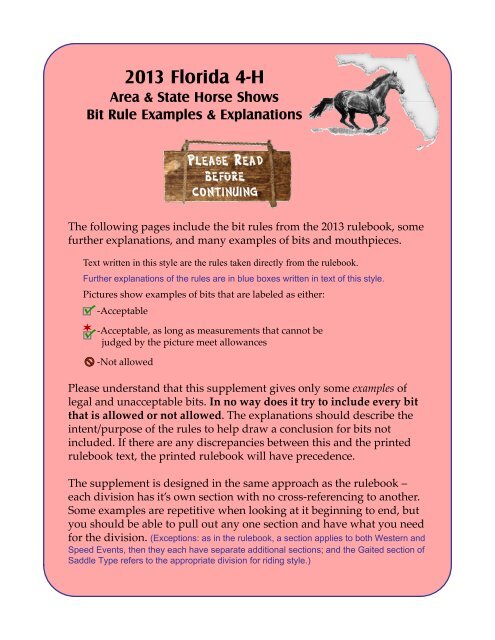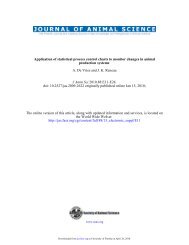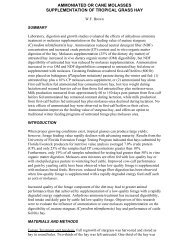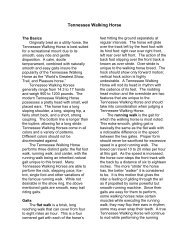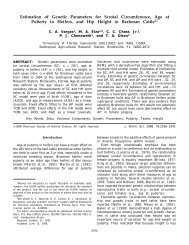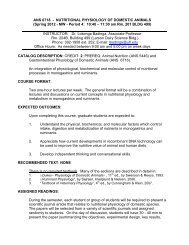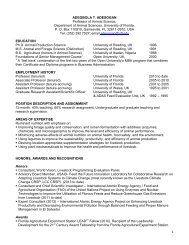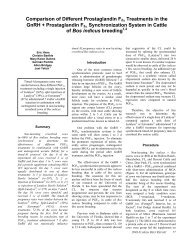Bit Rule explanations
Bit Rule explanations
Bit Rule explanations
Create successful ePaper yourself
Turn your PDF publications into a flip-book with our unique Google optimized e-Paper software.
2013 Florida 4-H<br />
Area & State Horse Shows<br />
<strong>Bit</strong> <strong>Rule</strong> Examples & Explanations<br />
Please Read<br />
before<br />
continuing<br />
The following pages include the bit rules from the 2013 rulebook, some<br />
further <strong>explanations</strong>, and many examples of bits and mouthpieces.<br />
Text written in this style are the rules taken directly from the rulebook.<br />
Further <strong>explanations</strong> of the rules are in blue boxes written in text of this style.<br />
Pictures show examples of bits that are labeled as either:<br />
‐Acceptable<br />
‐Acceptable, as long as measurements that cannot be<br />
judged by the picture meet allowances<br />
‐Not allowed<br />
Please understand that this supplement gives only some examples of<br />
legal and unacceptable bits. In no way does it try to include every bit<br />
that is allowed or not allowed. The <strong>explanations</strong> should describe the<br />
intent/purpose of the rules to help draw a conclusion for bits not<br />
included. If there are any discrepancies between this and the printed<br />
rulebook text, the printed rulebook will have precedence.<br />
The supplement is designed in the same approach as the rulebook –<br />
each division has it’s own section with no cross‐referencing to another.<br />
Some examples are repetitive when looking at it beginning to end, but<br />
you should be able to pull out any one section and have what you need<br />
for the division. (Exceptions: as in the rulebook, a section applies to both Western and<br />
Speed Events, then they each have separate additional sections; and the Gaited section of<br />
Saddle Type refers to the appropriate division for riding style.)
Western and Speed Events Divisions<br />
1. Reference to snaffle bits mean the conventional O-ring, egg-butt, or D-ring with ring no larger<br />
than 4" . The mouthpiece should be round, oval, or egg-shaped, smooth and unwrapped metal. It<br />
may be inlaid, but must be smooth. The bars must be a minimum of 5/16" in diameter, measured<br />
one inch in from the cheek with a gradual decrease to center of the snaffle. The mouthpiece may<br />
be two or three pieces. A three-piece connecting ring of 1 1/4" or less in diameter, or a connecting<br />
flat bar of 3/8" to 3/4" (measured top to bottom), which lies flat in the horse's mouth is<br />
acceptable.<br />
What does it mean … Snaffle Rings<br />
The shape of the snaffle ring outside of the horse’s mouth is unrelated to the style of mouthpiece<br />
on the inside. I.e., you cannot determine what is in the mouth by the shape of the ring. The<br />
acceptable shapes are O-ring, egg-butt, and D-ring. And regardless of which shape, the ring<br />
may not be more than 4 inches across at it’s widest point.<br />
O-ring<br />
Egg-butt<br />
Offset D-ring<br />
Full Cheek<br />
Not appropriate<br />
for Western<br />
More on mouthpieces after the next rule…<br />
2. References to a bit mean the use of a curb bit that has a solid or broken mouthpiece, has shanks,<br />
and acts with leverage. All curb bits must be free of mechanical device and should be considered<br />
a standard western bit. A description of a legal, standard western bit includes:<br />
A. 81/2" maximum length shank kto be measured as<br />
Standard d western curb bit<br />
indicated in the diagram illustrating legal bit. Shanks<br />
(one style of many)<br />
may be fixed or loose.<br />
B. Curb bit mouthpieces must be round, smooth, and<br />
unwrapped metal of 5/16" to 3/4" in diameter,<br />
measured one inch in from the cheek. They may be<br />
inlaid, but must be smooth. Nothing may protrude<br />
below the mouthpiece (bar), such as extensions or<br />
prongs on solid mouthpieces. The mouthpiece may be<br />
two or three pieces. A three-piece, connecting ring of<br />
Port<br />
1 1/4" or less in diameter, or a connecting flat bar of<br />
Mouthpiece (w/ roller)<br />
3/8" to 3/4" (measured top to bottom), which lies flat<br />
(bar)<br />
in the horse's mouth is acceptable.<br />
C. The port must be no higher than 3 1/2" maximum,<br />
with rollers and covers acceptable. Broken<br />
mouthpieces, halfbreeds, and spades are standard.<br />
Shanks<br />
2013 Western & Speed Events Page 1 of 4
Western and Speed Events Divisions, continued<br />
What does it mean … Mouthpieces<br />
Many of he parameters for mouthpieces are the same regardless if it is a snaffle or a curb. They<br />
need to be the same minimum diameter (5/16”) ), smooth, maybebrokenintotwoorthree<br />
broken two or three<br />
pieces, and if there is a connecting flat bar or ring, those connectors must meet the same<br />
respective measurements. Much of the determination of whether a mouthpiece is acceptable or<br />
not comes down to if it is smooth.<br />
What is “smooth”<br />
Smooth simply means that there are no bumps or ridges that will press into the bars of the<br />
horse’s mouth or the pressure points on the tongue when pressure is applied. Things that t make<br />
it not smooth may include (but are not limited to) any kind of twist, a wire wrap, carvings into the<br />
metal that create ridges, chain, etc.<br />
Mouthpiece examples (applies to both snaffle and curb bits):<br />
Simple jointed, smooth<br />
If connecting bar is<br />
3/8-3/4” top to bottom<br />
Not smooth<br />
Not smooth<br />
Not smooth<br />
If connecting bar is<br />
3/8-3/4” top to bottom<br />
Wire wrapped; “must<br />
be unwrapped metal”,<br />
not smooth<br />
Connecting O-ring g( (aka “Lifesaver) →<br />
can be a maximum of 1¼” diameter._ _<br />
← wrap on connector bar is acceptable because it<br />
is not a primary pressure point.<br />
Top is a fast twist or “corkscrew.” _ _<br />
Below is a slow twist. Both create _ _<br />
numerous sharp pressure points.__<br />
Twists and loose links = not smooth.<br />
← If the center link is a connecting flat bar,<br />
it must be 3/8” to 3/4” top to bottom.<br />
Both have metal inlay, but only the _ _<br />
top example is inlaid flat and smooth._ _<br />
The sample below has protruding links.__<br />
← <strong>Rule</strong> states “must be unwrapped metal.” This<br />
includes wire-wrapped.<br />
Connecting ring<br />
acceptable if
Western and Speed Events Divisions, continued<br />
3. References to a romal means an extension of braided material attached to closed reins. This<br />
extension may be carried in the free hand with an approximate 16" spacing between the reining<br />
hand and the free hand holding the romal. The rider’s hand shall be around the reins with the<br />
fingers closed, thumb on top, and no fingers between the reins.<br />
4. The romal shall not be used forward of the cinch or to signal or cue the horse in any way. Any<br />
infraction of this rule shall be penalized severely by the judge.<br />
Examples: Romal Reins<br />
Correct romal hold<br />
Romal reins<br />
Incorrect romal hold<br />
5. Chain curb straps are permissible, but must meet the approval of the judge, be at least 1/2" in<br />
width, and lie flat against the jaw of the horse. No wire curbs, regardless of how taped or padded.<br />
Absolutely no rigid material will be permitted under the jaws, regardless of how padded or<br />
covered.<br />
Examples: Curb Straps<br />
All of the above curb straps are acceptable<br />
OK if ≥ ½“ wide<br />
The curb straps below are NOT acceptable<br />
Chain
Western/Speed Events <strong>Bit</strong> Measurement<br />
8½ inches<br />
Maximum shank length<br />
(rule 2A)<br />
-measured from the inside top<br />
of the headstall ring to the<br />
‘pull point’ of the rein ring<br />
3½ inches<br />
Maximum port height<br />
(rule 2C)<br />
-measured from the top<br />
of the port to bottom of<br />
the bar<br />
5/16 to 3/4 inch diameter<br />
Mouthpiece width (rule 2B)<br />
-measured 1” in from cheek<br />
4 inches<br />
Maximum ring diameter<br />
(rule 1)<br />
-measuring outside of<br />
metal on largest part of<br />
ring or “D”<br />
5/16 inch diameter<br />
Minimum mouthpiece width<br />
(rule 1)<br />
-measured 1” in from cheek<br />
Connecting ring or flat bar on either curb or snaffle (rule 1 and 2B):<br />
Connecting ring, 1¼ inch<br />
maximum diameter<br />
Connecting flat bar, 3/8 – 3/4 inch<br />
maximum, measured top to bottom<br />
2013 Western & Speed Events Page 4 of 4
Western Division Only<br />
1. References to hackamore mean the use of a non-mechanical flexible, braided rawhide or leather,<br />
or rope bosal, the core of which may be either rawhide or flexible cable. Absolutely no rigid<br />
material will be permitted under the jaws, regardless of how padded or covered.<br />
What does it mean … Western Division Hackamores<br />
Bosals are the only type of hackamore allowed in the Western Division. These are simple,<br />
flexible hackamores with no metal or working parts. Nothing over the nose or under the jaw may<br />
be rigid.<br />
Rawhide bosal<br />
Easy/Fast stop<br />
Rigid material under jaw<br />
Mechanical Hackamore<br />
Fast stop<br />
Rigid material over<br />
nose; & mechanical<br />
2. Slip or gag bits, and donut and flat polo mouthpieces are not acceptable.<br />
What does it mean … slip/gag, donut, and polo mouthpieces<br />
Slip bits allow the mouthpiece to slide up the shank when pressure is applied, thereby<br />
increasing the leverage action in the mouth. With gag bits, the reins (attached directly to the<br />
headstall) slide through the bit rings and pull the mouthpiece up in a similar fashion. Neither type<br />
of ‘gag action’ is allowed.<br />
Flat polo mouthpieces are functionally the same as a Rutledge Roper. Neither are allowed in the<br />
Western division.<br />
Slip mouthpiece<br />
Gag action AND not smooth<br />
Gag bit<br />
Gag action not allowed<br />
Donut mouthpiece<br />
Flat polo mouthpiece<br />
2013 Western Page 1 of 2
Western Division Only, continued<br />
3. Horses five-years-old and younger may be<br />
shown in a snaffle bit, hackamore, curb bit,<br />
hlfb half-breed, or spade bit.<br />
A. When using a snaffle bit, a loose hobble<br />
strap is optional (leather or nylon only, no<br />
chain). Reins to be attached above the<br />
hobble strap, if used.<br />
B. Leather or woven split reins or mecate<br />
reins are acceptable with a snaffle bit.<br />
C. Junior horses (5 years old and under) that<br />
are shown with a hackamore or snaffle bit<br />
may be ridden with two hands on the<br />
reins. The rider's hands should be carried<br />
near the pommel and not further than 4"<br />
out on either side of the saddle horn.<br />
Rider's hands must be steady with very<br />
limited movement. Rider's hands should<br />
be visible to the judge(s) at all times.<br />
Examples … holding snaffle/bosal reins<br />
Mecote rein – one-piece<br />
continuous rein; separate rope<br />
attached to saddle or belt<br />
Correct hold<br />
Incorrect hold<br />
Incorrect hold<br />
Examples … holding curb reins<br />
Correct hold<br />
Incorrect hold<br />
Correct hold<br />
Correct hold<br />
Incorrect hold<br />
Incorrect hold<br />
Note: as stated in<br />
4B, any of these<br />
holds are acceptable<br />
in Ranch classes.<br />
4. Horses six-years-old and older may only be<br />
shown in a curb bit, half-breed, or spade bit.<br />
A. Only one hand may be used on the reins,<br />
and hand must not be changed. When<br />
using split reins, the hand is to be around<br />
the reins, and if desired only the index<br />
finger may be between the reins.<br />
Violation of this rule is an automatic<br />
disqualification.<br />
B. In ranch classes when showing in a curb<br />
bit, reins must be held in one hand, but<br />
may be held in any manner.<br />
Correct hold<br />
2013 Western Page 2 of 2
Speed Events Division Only<br />
1. References to hackamore mean the use of either a mechanical or non-mechanical hackamore.<br />
A. Non-mechanical: Flexible, braided rawhide or leather, or rope bosal, the core of which may<br />
be either rawhide or flexible cable.<br />
B. Mechanical: The core may be any flexible cable, rawride, or metal material, and must be<br />
covered with leather, soft plastic tubing, or similar material for padding.<br />
C. For either type of hackamore, absolutely no rigid material will be permitted over the nose or<br />
under the jaws, regardless of how padded or covered.<br />
What does it mean … Speed Events Hackamores<br />
Bosals and mechanical hackamores are allowed in the Speed Events Division. Regardless of<br />
what type of hackamore is used, The materials over and under the nose must be flexible.<br />
Rawhide bosal<br />
Mechanical Hackamore<br />
OK in Speed Events<br />
Easy/Fast stop<br />
Rigid material under jaw<br />
Stop & Turn<br />
Rigid material under jaw<br />
Fast stop<br />
Rigid material over<br />
nose<br />
2. Slip or gag bits will be allowed provided the mouthpiece and shank requirements/limitations are<br />
met as described in the Western & Speed Events section. “Rutledge Roper” bits will also be<br />
allowed.<br />
What does it mean … Slip/gag bits and Rutledge Roper<br />
Slip bits allow the mouthpiece to slide up the shank when pressure is applied (reins pulled),<br />
thereby increasing the leverage action in the mouth. With gag bits, the reins (attached directly to<br />
the headstall) slide through the bit rings and pull the mouthpiece up in a similar fashion. <strong>Bit</strong>s with<br />
this kind of ‘gag action’ are allowed in Speed Events.<br />
Flat mouthpiece Rutledge<br />
Roper bits are also acceptable.<br />
The mouthpiece of which<br />
should rotate freely on the<br />
shanks so it remains flat on<br />
the tongue when pressure is<br />
applied.<br />
Rutledge Roper<br />
Speed events only<br />
Wonder <strong>Bit</strong><br />
Gag action OK<br />
Gag action OK, BUT<br />
Mouthpiece not smooth<br />
3. Horses of any age may be shown with a snaffle bit.<br />
4. Riders may use two hands on the reins regardless of type of bit and age of horse.<br />
5. Judge or appointed equipment official may prohibit the use of bits or equipment deemed too<br />
severe.<br />
2013 Speed Events Page 1 of 1
Hunter Division<br />
1. Snaffle, pelham, kimberwick, or full bridles (Weymouth) are permitted. If a bit is used that<br />
requires two reins, it may not be used with a converter.<br />
What does it mean … <strong>Bit</strong> types<br />
Snaffles: The shape of the snaffle ring outside of the horse’s mouth is unrelated to the style of<br />
mouthpiece on the inside. I.e., you cannot determine what is in the mouth by the shape of the<br />
ring. The acceptable shapes are O-ring, egg-butt, D-ring, and full cheek.<br />
O-ring/Loose ring Egg-butt<br />
Offset D-ring D-ring<br />
Full Cheek<br />
Pelhams and Kimberwicks use a snaffle and/or curb action. A pelham has a<br />
shank and requires reins to be attached to both the snaffle ring and curb ring.<br />
Kimberwicks have ‘cut-outs’ where a rein can be attached to either location – one resulting in<br />
more snaffle action and one with more curb action. Full bridles (Weymouths) have separate curb<br />
& snaffle (bridoon) bits and require two reins.<br />
Kimberwick<br />
2 location options to<br />
attach one rein<br />
Either rein attachment<br />
location is acceptable.<br />
Pelham w/two reins<br />
Correct use of pelham<br />
Pelham w/converter<br />
<strong>Bit</strong> requires 2 reins, so can<br />
not be used with converter<br />
2. <strong>Bit</strong>s must be at least 5/16" or larger in diameter. The mouthpiece may consist of one, two, or<br />
three pieces and must be smooth. Waterford bits are permitted. Any port may not be taller than<br />
11/2“ 1/2 . (Mouthpiece examples on next page.)<br />
3. Slow or fast twist, corkscrew, twisted wire, double twisted wire, and triangle (knife edge) bits are<br />
not allowed. True gag action and elevator bits are not allowed.<br />
What does it mean … gag and elevator bits<br />
With gag bits, straps connect the reins directly to the headstall, sliding through the bit rings.<br />
When pressure is applied, it pulls the mouthpiece up higher in the mouth. Elevator bits have an<br />
exaggerated height headstall attachment, or mouthpieces that slide up & down on the cheek<br />
rings, and create a mouthpiece-lifting gag action when pressure is applied.<br />
Gag bit<br />
True gag action<br />
European or 3-ring Elevator <strong>Bit</strong><br />
Elevator <strong>Bit</strong><br />
2013 Hunter Page 1 of 4
Hunter Division, continued<br />
What does it mean … Mouthpieces<br />
Regardless of the type of bit (snaffle, pelham, kimberwick, etc.), mouthpieces must meet the<br />
same requirements. Mouthpieces may be solid (one piece) or broken (two or three pieces). After<br />
meeting the minimum diameter (5/16 inch), much of the determination of whether a mouthpiece<br />
is acceptable or not comes down to if it is smooth.<br />
What is “smooth”<br />
Smooth simply means that there are no bumps or ridges that will press into the bars of the<br />
horse’s s mouth or the pressure points on the tongue when pressure is applied. Things that make<br />
it not smooth may include (but are not limited to) any kind of twist, a wire wrap, carvings into the<br />
metal that create ridges, chain, etc.<br />
Mouthpiece examples:<br />
Simple jointed, smooth<br />
Waterford bit is specifically listed as acceptable.→<br />
Three smooth, round balls linked together<br />
Waterford <strong>Bit</strong><br />
Three piece mouthpiece<br />
← Three-piece with connecting flat bar. Smooth<br />
and within rules.<br />
Not smooth<br />
Not smooth<br />
Not smooth<br />
Top is a fast twist or “corkscrew.” _ _<br />
Below is a slow twist. t Both create _ _<br />
numerous sharp pressure points.__<br />
Twists and lose links = not smooth.<br />
Mouthpiece not smooth<br />
Mouthpiece not smooth<br />
Not smooth<br />
Wire wrapped; not smooth<br />
Triangle or knife-edge edge bit. →<br />
Sharp edge is very sharp_ _<br />
on the bars & tongue._ _<br />
← Three piece with port as connector. Smooth<br />
and within rules. ues<br />
Port is less than 1½”<br />
Port is less than 1½”<br />
Multiple rollers set in the mouthpiece →<br />
result in many pressure points._<br />
Sharp edge is not smooth<br />
Mouthpiece not smooth<br />
Port is less than 1½”<br />
← One piece with wide port. Smooth and within<br />
rules.<br />
Mouthpiece made of a series of rollers. →<br />
It is still smooth against the bars & tongue._ _<br />
Rollers are smooth<br />
_<br />
2013 Hunter Page 2 of 4
Hunter <strong>Bit</strong> Measurement<br />
5/16 inch diameter<br />
Minimum mouthpiece width<br />
(rule 2)<br />
-measured 1” in from cheek<br />
-regardless of type of bit<br />
1½ inches<br />
Maximum port height (rule 2)<br />
-measured from the top of the port<br />
to bottom of the bar<br />
-regardless of type of bit<br />
Dressage <strong>Bit</strong> Measurement<br />
3/8 inch diameter<br />
Minimum mouthpiece width<br />
-measured at rings/cheek<br />
-regardless of type of snaffle<br />
2013 Hunter Page 3 of 4
Dressage<br />
Even though Dressage is in the Hunter Division, it has different<br />
rules for bits allowed. Some bits that are allowed in other Hunter<br />
classes are not acceptable in the Dressage classes.<br />
All bits must be smooth and with a solid surface. Twisted, wire and roller bits are prohibited. A bushing or<br />
coupling is permitted as the center link in a double jointed snaffle; however, the surface of the center piece<br />
must be solid with no moveable parts. The mouthpiece of a snaffle may be shaped in a slight curve, but ported<br />
snaffles are prohibited.<br />
<strong>Bit</strong>s must be made of metal or rigid plastic and may be made with a rubber, plastic or leather covering; flexible<br />
rubber bits are not permitted. <strong>Bit</strong>s may not be modified by adding latex or other material. <strong>Bit</strong>s with<br />
mouthpieces made of synthetic material are permitted, provided that the contours of the bit conform to the<br />
contours of one of the bits pictured. The diameter of the snaffle mouthpiece must be minimum 3/8 inch<br />
diameter at rings or cheeks of the mouthpiece.<br />
Numbers 1, 2, 6, 8, 10, 11, and 12 describe mouthpieces that can be with any acceptable ring/cheek.<br />
Numbers 3, 4, 5, 7, and 9 describe rings/cheeks that can be with any acceptable mouthpiece.<br />
Acceptable mouthpiece + acceptable ring/cheek = Legal <strong>Bit</strong> for Dressage<br />
1. Ordinary snaffle with single-jointed mouthpiece.<br />
3. Racing snaffle (D-ring).<br />
2. Ordinary snaffle with double-jointed mouthpiece.<br />
6. Unjointed snaffle (Mullen-mouth).<br />
4. Snaffle: with cheeks, with or without keepers.<br />
-without cheeks (Egg-butt).<br />
8. Dr. Bristol.<br />
10. French snaffle.<br />
11. Snaffle with rotating mouthpiece.<br />
12. Rotary bit.<br />
Dr. Bristol: connecting<br />
bar is more rectangular<br />
and rests at an angle to<br />
the tongue.<br />
French link: connecting<br />
bar is a rounded-corner<br />
dog bone shape and<br />
rests flat on the tongue.<br />
Both #11 and #12 rotate<br />
forward and back from<br />
the center joint.<br />
5. Snaffle with upper or lower cheeks.<br />
7. Snaffle with cheeks. (Hanging or drop cheek;<br />
Baucher). This may be a D-ring or other<br />
ordinary snaffle as<br />
pictured in Nos. 1-6<br />
9. Fulmer.<br />
Ported snaffles<br />
prohibited<br />
No rollers/moveable<br />
parts in center link<br />
No flexible rubber bits<br />
2013 Hunter Page 4 of 4
Saddle/Gaited Division<br />
Saddle Seat<br />
1. Horses must be shown in full bridles (curb and snaffle) or pelham with two reins. Snaffle bridles<br />
will only be allowed in Saddle Seat Pleasure, Trotting; Showmanship; and Conformation classes.<br />
2. <strong>Bit</strong>s must be at least 5/16" or larger in diameter. The mouthpiece may consist of one, two, or<br />
three pieces and must be smooth. Waterford bits are permitted. Any port may not be taller than<br />
1 1/2“. (Mouthpiece examples on next page.)<br />
3. Design of the bridoon mouthpiece must conform to that of acceptable snaffles in previous rule.<br />
However, smaller dimensions of the mouthpiece are permissible.<br />
4. <strong>Bit</strong>s with shanks over 8 1/2" in length are not permitted.<br />
What does it mean … <strong>Bit</strong> types<br />
Pelhams and full bridles (Weymouth) use a snaffle and/or curb action, depending on which<br />
rein is pulled. A pelham has a shank and requires reins to be attached to both the snaffle ring<br />
and curb ring.<br />
Pelham, Broken mouthpiece<br />
Must be used with 2 reins<br />
Pelham w/two reins<br />
Correct use of pelham<br />
Pelham w/converter<br />
<strong>Bit</strong> requires 2 reins, so can<br />
not be used with converter<br />
Walking Horse <strong>Bit</strong>s<br />
OK if shanks measure ≤ 8½ ”<br />
Full bridles (Weymouths) have separate curb & snaffle (bridoon) bits and require two reins.<br />
Bridoons:<br />
← 3-piece mouthpiece<br />
← Twisted mouth; not<br />
smooth<br />
← single jointed mouth<br />
Gaited<br />
1. Bridles/bits should coincide with the style<br />
of riding chosen. See the appropriate section<br />
(Western, Hunter, or Saddle Seat) for bit<br />
requirements.<br />
2. Paso Finos may show in hackamores as<br />
approved by PFHA for Pleasure classes.<br />
What does it mean … <strong>Bit</strong>s for Gaited<br />
Gaited horses may be shown in Western,<br />
Hunter, or Saddle type tack, depending on<br />
the breed of the horse and/or the<br />
preferences of the exhibitor. Follow the bit<br />
rules for the style of riding used.<br />
Paso Finos often show in types of<br />
hackamores not described in this section.<br />
See the PFHA rules for Paso bridles.<br />
2013 Saddle/Gaited Page 1 of 3
Saddle/Gaited Division, continued<br />
What does it mean … Mouthpieces<br />
Regardless of the type of bit (snaffle, pelham, weymouth, etc.), mouthpieces must meet the<br />
same requirements. Mouthpieces may be solid (one piece) or broken (two or three pieces). After<br />
meeting the minimum diameter (5/16 inch, except bridoons), much of the determination of<br />
whether a mouthpiece is acceptable or not comes down to if it is smooth.<br />
What is “smooth”<br />
Smooth simply means that there are no bumps or ridges that will press into the bars of the<br />
horse’s s mouth or the pressure points on the tongue when pressure is applied. Things that make<br />
it not smooth may include (but are not limited to) any kind of twist, a wire wrap, carvings into the<br />
metal that create ridges, chain, etc.<br />
Mouthpiece examples:<br />
Simple jointed, smooth<br />
Waterford bit is specifically listed as acceptable.→<br />
Three smooth, round balls linked together<br />
Waterford <strong>Bit</strong><br />
Three piece mouthpiece<br />
← Three-piece with connecting flat bar.<br />
Smooth and within rules.<br />
Not smooth<br />
Not smooth<br />
Not smooth<br />
Top is a fast twist or “corkscrew.” _ _<br />
Below is a slow twist. t Both create _ _<br />
numerous sharp pressure points.__<br />
Twists and lose links = not smooth.<br />
Mouthpiece not smooth<br />
Mouthpiece not smooth<br />
Not smooth<br />
Wire wrapped; not smooth<br />
Triangle or knife-edge edge bit. →<br />
Sharp edge is very sharp_ _<br />
on the bars & tongue._ _<br />
← Three piece with port as connector.<br />
Smooth and within rules. ues<br />
Port is less than 1½”<br />
Port is less than 1½”<br />
Multiple rollers set in the mouthpiece →<br />
result in many pressure points._<br />
Sharp edge is not smooth<br />
Mouthpiece not smooth<br />
Port is less than 1½”<br />
← One piece with port. Smooth and within<br />
rules as long as port is 1½” or less.<br />
Mouthpiece made of a series of rollers. →<br />
It is still smooth against the bars & tongue._ _<br />
Rollers are smooth<br />
_<br />
2013 Saddle/Gaited Page 2 of 3
Saddle/Gaited <strong>Bit</strong> Measurement<br />
Pelham<br />
with 3-piece mouthpiece<br />
1½ inches<br />
Maximum port height (rule 2)<br />
-measured from the top of the port<br />
to bottom of the bar<br />
-regardless of type of bit<br />
5/16 inch diameter<br />
Minimum mouthpiece width<br />
(rule 2)<br />
-measured 1” in from cheek<br />
-regardless of type of bit Weymouth w/<br />
bridoon<br />
Walking Horse <strong>Bit</strong><br />
with 2-piece mouthpiece<br />
Bridoon mouthpiece (rule 2)<br />
-may have smaller diameter than<br />
5/16 inch<br />
-Weymouth (curb) portion must<br />
still be 5/16 inch minimum<br />
8½ inches<br />
Maximum shank length (rule 4)<br />
-measured from the inside top of<br />
the headstall ring to the ‘pull<br />
point’ of the rein ring<br />
2013 Saddle/Gaited Page 3 of 3


